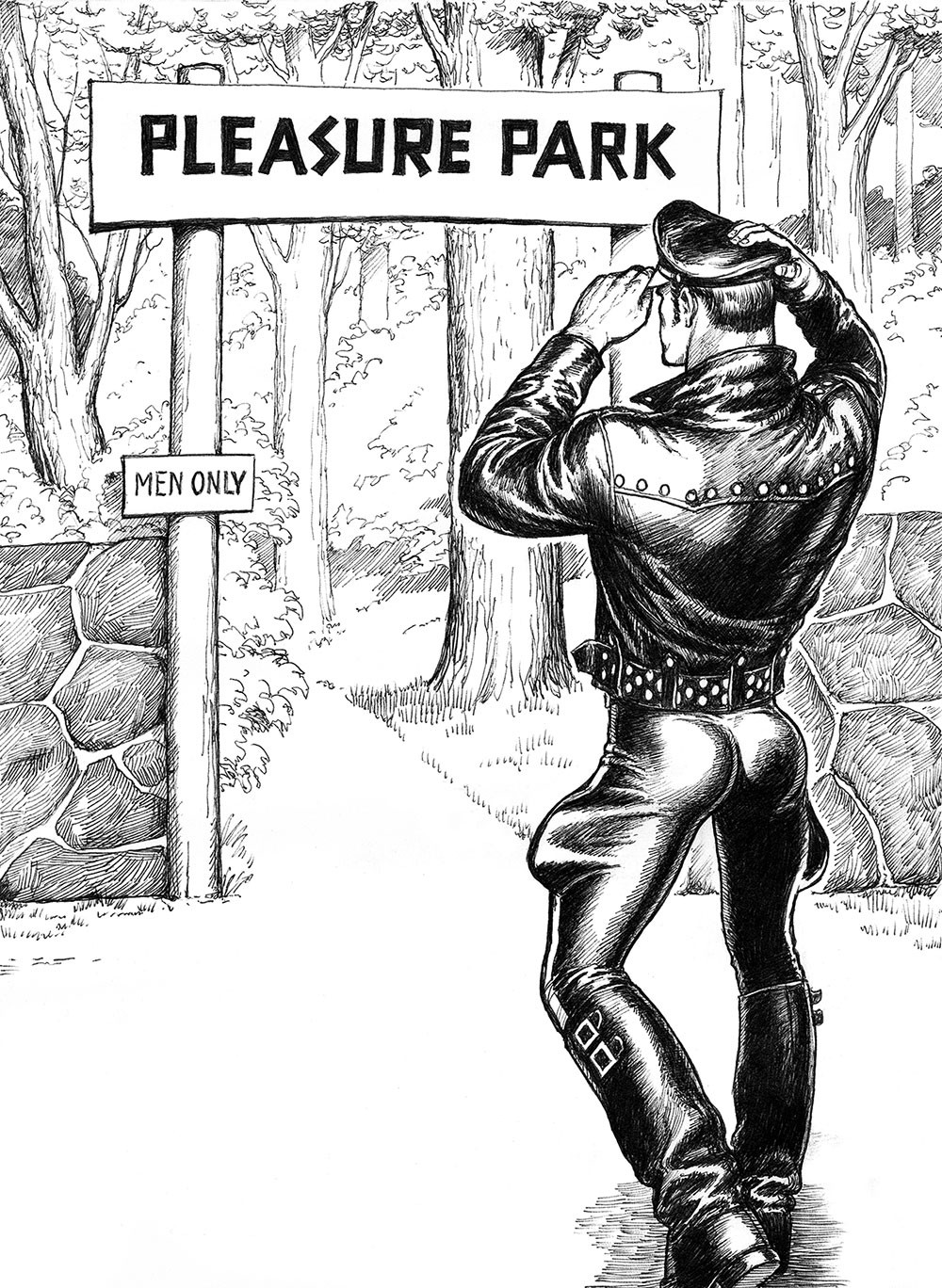I was in Berlin for Folsom Europe a couple of weeks ago, and one of the side events was an exhibition of artwork by contemporary artists inspired by Tom of Finland (along with several pieces of ToF work).
Folsom Europe is, in itself, a living, breathing performance of Tom of Finland influences. Stand on any corner and you are surrounded by a vast display of hyper-masculinity, and if you squint your eyes you could almost frame it.
Why does Folsom look like it does? There is an entrenched story in Leather history about how it grew out of a reaction to the “femme image” of the gay scene. For example, in a recent Reuters article on the gentrification of the SoMA district in San Francisco, the writer says:
It catered to gay men who dressed in leather, a symbol of homosexual masculinity in contrast with the more effeminate attitude of groups of gay men congregating elsewhere in San Francisco.
Or, take this recent piece in the Guardian, which says:
Among gay men, leather was also a rejection of the tropes of effeminacy and passivity that homosexuality had accrued since the mid 19th century, a disavowal of the “sweater queens” – well-to-do, preppy gay men – of the time. “Leather was everything that the self-consciously effeminate homosexuals weren’t. They were some of the first gay men to reclaim masculinity,” says Eric Chaline, author and historian of gay sadomasochism.
My understanding, and my observations from the Leather community is that there is some truth in this spin on history, but it’s not really the complete truth.
Not everyone in Leather is “not effeminate”. Not everyone is a Top or a “masculine bottom”. Not everyone is beefed up. Leather is not really about gender expression at all. Yet the myth persists, because the hyper-masculine appearance, or optics, of Leather make it easy to draw that conclusion.
DEPICTING THE MALE BODY
Tom of Finland isn’t the first to depict male “perfection” of course. Classical Western art is full of beautiful men, and Japan, China and many other non-Western countries have equally rich traditions. There is even a long tradition of exaggeration of the phallus.
But ToF was certainly early in adopting the style of consistent idealisation, depicting his men as being both realistic and impossible. And, he was amongst the first to incorporate the leather theme, previously only hinted at in the rough trade of Cocteau or the refined gentry of Montoergeuil.
Where Classical art depicted Gods as beautiful men, ToF depicted men as beautiful Gods.
WHY DID OUR AESTHETICS CHANGE?
There are several things that probably influenced our growing romance with the gym, and our adoption of other trends (that go in and out of style) such as piercing, tattoos and beards.
In the 60s and 70s, leather was very often required if you wanted to participate in BDSM, so if your fetishes ran in that direction then gaining entry to the venues that catered to your desires probably meant adopting the dress code. In the 80s, as understanding about the AIDS crisis developed, men also wanted to outwardly project an image of health.
One of the reasons leather became a dress-code requirement at venues was fear of persecution. There was a very real possibility of clubs being raided, or patrons being ensnared in sting operations.
There is a primalness that goes with many gay kinks. Part of the attraction to activities like fisting and impact play is its brutal side. It’s a raw, masculine energy, and it’s often these qualities that we seek in a partner. So, along with the leather, the hypermasculinity becomes a dude-magnet in this world.
In previous decades, it was a combination of both that got you what you wanted. The Leather got you through the door, the masculine image got you the kink you were looking for.
WE’RE STILL DRESSED AS WE WERE IN THE 70s
Leather doesn’t look exactly as it did in the 70s. We have some great colour options, and there are a lot more pups running around than there used to be.
But if you look around at Folsom, overall the changes are small. The bar vests, the jackets, the knee-high boots and the Muir caps are traditional and dominant symbols. The gym-pumped body is still the gold standard and an enormous effort still goes into projecting a masculine image.
It’s exemplified in groups like BLUF (The Breeches and Leather Uniform Fanclub) which requires emailed pictures conforming to a fairly strict dresscode for membership.
Overall, Tom of Finland wouldn’t find much about the 2018 Folsom unfamiliar.
It’s partly the tradition that supports the look, in much the same way that a professional Dominatrix would look familiar to one from the 70s, or the suit and tie is still the uniform of board-rooms. People *want* to look the part.
THE BEGINNINGS OF CHANGE?
Alongside our increasing understanding about gender and sexuality, if you look closely at a gay Leather crowd now, you’ll see that it’s not as homogenous as you might think at first glance. Expressions of fashion and fluidity are well-accepted.
More than that, we’re also seeing a move away from the strict gay-Leather-BDSM linkage of the past, and there is good reason for that. Leather is no longer the key that opens the door to fulfilling your kink desires. You can fire up your phone and unlock that door any time.
And, for the same reason, many Leather events are not required to fulfil that purpose either. They’ve become more social, more tribal, more educational. In many cases, they no longer need to be men-only, so there has been a shift towards more gender inclusivity.
We are seeing a shift in the *purpose* of Leather. Will it change the optics?
Hypermasculinity and the legacy of Tom of Finland have been with us for a long time. It’s an entrenched part of Leather culture. Men are still going to want to have sex with men in rough and primal ways, and they will still want to signal that in the expression of their identity. I don’t think that is going to change, so if you’ve invested a lot in your leather your investment is probably safe for many more years to come.
FURTHER READING
• Rolling Stone – Inside the Changing Leather Scene
• The Guardian – Why is the Leather Scene Dying?
• Deviance & Desire – Dressing Up Isn’t Just For Children
• Deviance & Desire – An Illustrated Guide to Gay Semiotics


Am a sissy boi. How can I further my desire to serve someone in the bdsm community.am in the manassas,va area